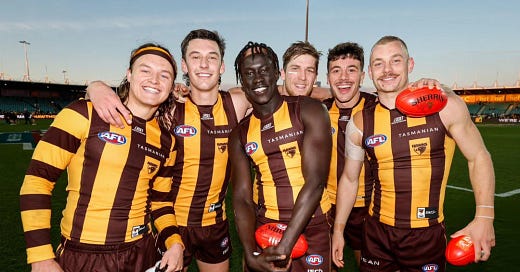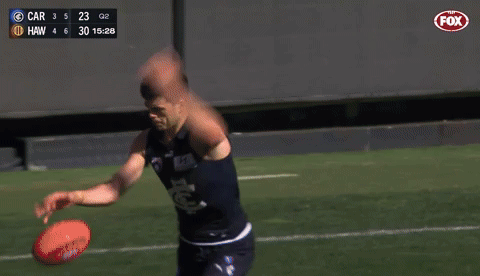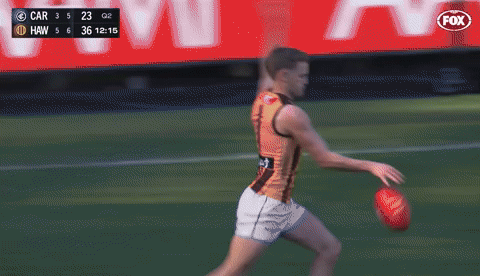Subscribe to Hawks Insiders for the most in-depth and wide ranging Hawthorn cover there is. From exclusive interviews to analysis, match recaps to podcasts, the Insiders have you covered.
If there is more evidence required on how much this sport we all love is a results-based industry (shout out to Brad Scott) - look no further than the media 360 on Hawthorn this year.
The media are falling over themselves to shower us with praise - in particular our ‘mosquito fleet’ of wings and forwards.
However, despite being well intended – I feel personally the term ‘mosquito fleet’ undersells the group greatly. Watching them live on the weekend from level 4 of the MCG – they’re not mosquitos. They’re wildebeests.
Bear with me here. According to big fan of HI, Mr. Joseph Conlon of the American Mosquito Control Association, mosquitos can only fly for around 10 minutes before they need to rest.
The wildebeest on the other hand – can travel over 80km a day on foot. This, I feel is a far more accurate description for the pure work rate of our outside runners.
Yes, some of these boys love a celebration and enjoy riling up the opposition. They play with flair when the ball is their hands. However – this is only possible due to how workmanlike they are without the ball.
Their endurance is unbelievable, the way they cover ground – both running attacking patterns to get the ball themselves, the selfless running to set up our shape and the way we want to use the ball by opening space for others, is elite.
This isn't by accident.
Massimo D’Ambrosio - one of our said wildebeests – said recently on 3AW that 13 players broke time trial PBs in pre-season. With a slight lack of absolute A+ echelon talent compared to other clubs - I only really class Will Day and Josh Weddle currently as those who were drafted into our club with ‘natural’ A+ AFL skillsets – our rise of late has been through absolutely manic work rate in defence and attack and having an extremely even spread across the board of talent and output.
Sam Mitchell has identified that we have some excellent intercept markers in defence – mainly James Sicily, Jack Scrimshaw, Weddle and Sam Frost – and knows that we can use this to attack, and fast.
Something that is so clear about the Hawthorn game plan – and why we are moving the ball so beautifully from defence to attack – is we make the ground big.
Our wingers and high half forwards – namely D’Ambrosio, Dylan Moore, Connor Macdonald, Harry Morrison / Changkouth Jiath, Jack Ginnivan, Nick Watson and even Jack Gunston – are excellent at holding space and width and not getting sucked into wanting the football every time we get it back on turnover.
Mitchell says to his small forwards that he wants them high enough to get 20 disposals but close enough to have three shots at goal. This is great in theory, but requires a structure and a willingness to work, and work HARD.
This is reflected in the limited GPS data made available to the public. You’d think that, most of the time, distance stats would be dominated by inside mids or those that attend a lot of CBAs. Not us.
On the weekend – we were led by Macdonald and Moore who recorded 3.2 and 2.7km respectively for distance covered at high speed.
Against Adelaide – Moore and D’Ambrosio led this stat. Against Collingwood, Jiath (playing on a wing) and Moore. Against Freo, Macdonald and Jiath. Watson has been in the top five players on the ground for total sprints in every game since Geelong.
This gives us an incredibly well-balanced attack and options in the way we want to move the ball. Often, we win the ball back in defence and our wingers and half forwards, who have the license to get back and help – will instantly run two diagonal patterns – one will come up towards basically the Telstra logo on defensive 50 and the second is hard out to centre wing.
The kick to the Telstra logo is often an outlet kick option to help us out of defence, while the centre wing kick is a secondary option which allows us to get numbers ahead of the ball and keep our chains moving.
What does making the ground big do?
Firstly, it opens up the corridor. This allows two attacking options for our half backs – usually Weddle, Karl Amon and Jarman Impey - to take grass and link up through hands, or they can use this space to hit up an option at centre half back.
The first example is seen here in the coast-to-coast goal in the third quarter where Moore pushing to the first pattern leaves us with a fast four-on-one through the middle of the ground through the aforementioned three half backs.
Gunston, despite having little to no chance of receiving the ball, has pushed up to centre wing to run the second pattern here – which draws another option outside 50 and away from the corridor. The result is Calsher Dear and Watson can raffle off who wants to kick the goal and we kick one from the goal line.
Here is a great example of the second option where the spread wide helps open up this gaping hole for Macdonald to mark unopposed.
Secondly, it gives us the ability to take this width by using these options, and move the ball with run along the wing, quickly. The speed of the ball movement here doesn't allow opposition defence time to get set and allows further options down the line. It is vital that although using it by foot, the ball movement is still fast to allow us to use our positional advantage. This requires being predictable in our attacking running patterns which I've explained earlier.
Here, we see us move the ball down the southern wing. Harry Morrison has run the Telstra logo pattern to receive the ball after turnover but the members wing isn’t on. He switches, and Moore ends up running the centre wing pattern to receive. Interestingly – Massimo is the shorter option here, again making the ground as big as possible. He isn’t used, but its another defender drawn away and allowing Moore more space over the back. Meek gets the 50 and we goal.
Thirdly, it gives us the ability for our inside mids and on-ballers to run to 60 out directly in front and provide an option to bring the ball back inside via a quick 45.
Here, an intercept mark allows us a fast play to find Gunston at half forward. You will notice that Moore and D’Ambrosio are still running to make the ground big to the outside of Gunston but are not used. There is a gaping hole at CHF where Gunston is able to come inside and find Nash.
What does it all mean?
We are second for points for since Round 11, and in the top two of every single category of score production – turnover, clearance, centre bounce and kick in. It’s also no coincidence that our lowest score and worst performance since the bye was against the Cats, at the narrowest ground in the AFL. I’d LOVE to get them in a final at the ‘G.
There is nothing groundbreaking about what I've outlined here – but it requires having a huge tank, ability to use the tank every time we force a turnover and a willingness to be predictable to your teammates with and without the ball.
So I encourage you, whether it be this weekend against the Tigers or (hopefully!) in September, next time you see the Hawks play live – sit in level 4 and watch our wildebeests roam.
Don’t forget to listen in as the HI team goes live on Wednesday nights on X (Twitter). Follow us on social media through the links below:













Well written and fantastic article on our fast paced ball movement.
I too noticed the players running patterns from defence.
Huge shout out to Burge and his fitness team on their fitness.
Huge shout out to the youngsters for jumping on board.
The difference between round 5 play to now is staggering to say the least.
That spring air is almost upon us, I can smell it.
To think this team will most likely be part of it is incredible.
I said 8 weeks ago this has a touch of 2008 all over it.
If we make it, anything can happen 🤎💛
Awesome read, well done Nat.
Now we just have to mark this TOP SECRET and keep it away from the opposition...